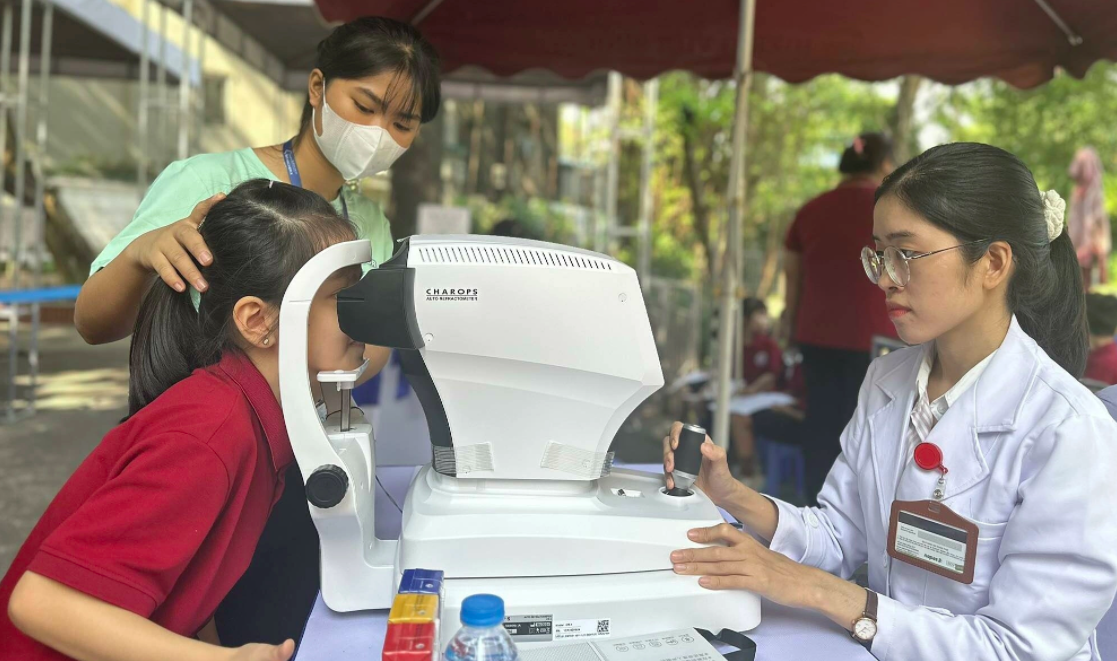Experts shared this information at the 5th Global Ortho-K and Myopia Control Conference, alongside the 3rd Vietnam Refractive Eye Care Conference (GOMCC 2025). Hanoi Medical University and the Asia Pacific Refractive Eye Care Society hosted the event from 22/8 to 24/8 in Hanoi. Specialists from the US, Canada, Australia, Japan, South Korea, Singapore, and Vietnam gathered to share the latest scientific evidence, clinical practices, and foster collaboration in ophthalmology research and training.
Tran Minh Anh, Vice President of the Asia Pacific Refractive Eye Care Society, noted the increasing prevalence of refractive errors, particularly myopia, globally, especially in East and Southeast Asia. Southeast Asia ranks third globally in myopia rates.
"Vietnam's myopia rate is also rising, with urban areas showing significantly higher rates among children compared to rural areas," Anh said.
Data from the Ministry of Health show a sharp increase in refractive errors in recent years, highest in Hanoi and Ho Chi Minh City, affecting 50-70% of students. Studies in Ho Chi Minh City, for instance, reveal higher myopia rates among inner-city children compared to suburban children, and among secondary school students compared to primary school students. Notably, specialized schools show higher myopia rates than other schools.
 |
Students at Hoang Dieu Primary School (Hanoi) undergo eye examinations. Photo: Le Nga |
Students at Hoang Dieu Primary School (Hanoi) undergo eye examinations. Photo: Le Nga
Congenital (inherited) myopia accounts for about 30% of cases. This condition is difficult to prevent or control without early screening or proactive eye exams at specialized clinics. The remaining 70% of cases are linked to lifestyle factors. These include prolonged near-work activities, early exposure to electronic devices, intense studying, inadequate lighting, and lack of eye rest.
"The rising myopia rate is especially attributed to insufficient outdoor time during the day, less than two hours per day," Anh explained, adding that these habits force the eyes to constantly focus at close range, leading to myopia. Higher degrees of myopia increase the risk of eye complications, potentially causing blindness, particularly in children or individuals with high myopia. This can become a significant economic and social burden.
Currently, refractive correction is the only way to ensure good vision for children with myopia, enabling them to learn, live, and develop normally. Eye surgery is only for individuals over 18; refractive surgery is not permitted for children. Therefore, children need appropriate glasses to protect their eyes and prevent further myopia progression.
Experts recommend the simplest, most effective, and affordable method: ensuring children have at least two hours of outdoor activity each day. This can prevent the onset of myopia.
 |
Professor Nguyen Huu Tu, President of Hanoi Medical University, speaks at the conference. Photo: Thai Son |
Professor Nguyen Huu Tu, President of Hanoi Medical University, speaks at the conference. Photo: Thai Son
At the conference, Professor Nguyen Huu Tu, President of Hanoi Medical University, also emphasized that myopia among students is a major public health issue requiring strategic intervention to control its increasing prevalence. Hanoi Medical University is one of the first two universities in Vietnam to offer a refractive ophthalmology program, which continues to develop today.
Given the growing demand for vision care, Tu stated that Vietnam's ophthalmology sector is focusing on developing high-quality human resources, promoting specialized training and scientific research, and implementing community outreach programs, including early screening and intervention for myopia and other refractive errors in children and adults.
Le Nga












